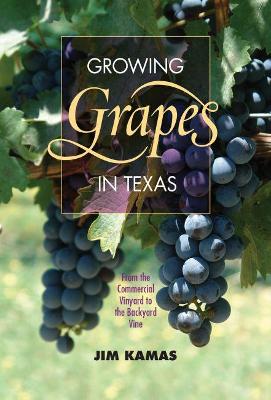Texas A&M AgriLife Research and Extension Service
2 total works
In this complete and approachable manual on grape growing in Texas, Jim Kamas asks the essential question all potential growers need to answer: Why do you want to plant a vineyard?
Outlining the challenges and risks to all who think viticulture is a weekend hobby, Kamas then identifies the state's current grape growing regions and covers everything the commercial or home producer needs to know in order to have a successful vineyard.
Well-illustrated text offers chapters on site choice and design, rootstock and fruiting varieties, pruning and training strategies, canopy and floor management, and disease and pest control. Kamas thoroughly explores grapevine horticulture, including the systematics, morphology, nutrition, and water needs of the genus Vitus. Finally, he addresses the issues of equipment and infrastructure before closing with some advice about vineyard-winery relations.
Kamas was trained as a student in the grape growing country of western New York by some of the ""best viticultural minds"" in the US, and grape and wine lovers from all parts of the country will find this book a valuable resource.
Outlining the challenges and risks to all who think viticulture is a weekend hobby, Kamas then identifies the state's current grape growing regions and covers everything the commercial or home producer needs to know in order to have a successful vineyard.
Well-illustrated text offers chapters on site choice and design, rootstock and fruiting varieties, pruning and training strategies, canopy and floor management, and disease and pest control. Kamas thoroughly explores grapevine horticulture, including the systematics, morphology, nutrition, and water needs of the genus Vitus. Finally, he addresses the issues of equipment and infrastructure before closing with some advice about vineyard-winery relations.
Kamas was trained as a student in the grape growing country of western New York by some of the ""best viticultural minds"" in the US, and grape and wine lovers from all parts of the country will find this book a valuable resource.
An up-to-date guide for commercial and residential peach growers . . . With an estimated one million trees producing almost fifty million pounds of fruit per year, Texas is a leading producer of peaches, and several popular seasonal festivals highlight the widespread enjoyment of and interest in this delicious, versatile fruit. In addition, a recent rise of interest in edible gardens and home fruit production has led more people to think about planting a peach tree in the yard - or paying closer attention to the one they already have.
Jim Kamas and Larry Stein, drawing from their many years of experience and the best current research, provide authoritative advice for those who want to improve peach production, whether in a large commercial orchard or on a single tree in the back yard. With discussions ranging from site selection to marketing ideas,Texas Peach Handbookcovers the basics of peach cultivation - planting, pruning, fertilizing, watering, protecting, thinning, harvesting - and gives bothinstruction on disease and insect control and advice on the financial aspects of the peach business. The authors also direct readers to other, more detailed or technical sources, for those who want to learn more about a given topic.
For its useful information and expert guidance, this how-to handbook will prove indispensable for anyone who grows, or wants to grow, peaches.
Jim Kamas and Larry Stein, drawing from their many years of experience and the best current research, provide authoritative advice for those who want to improve peach production, whether in a large commercial orchard or on a single tree in the back yard. With discussions ranging from site selection to marketing ideas,Texas Peach Handbookcovers the basics of peach cultivation - planting, pruning, fertilizing, watering, protecting, thinning, harvesting - and gives bothinstruction on disease and insect control and advice on the financial aspects of the peach business. The authors also direct readers to other, more detailed or technical sources, for those who want to learn more about a given topic.
For its useful information and expert guidance, this how-to handbook will prove indispensable for anyone who grows, or wants to grow, peaches.

